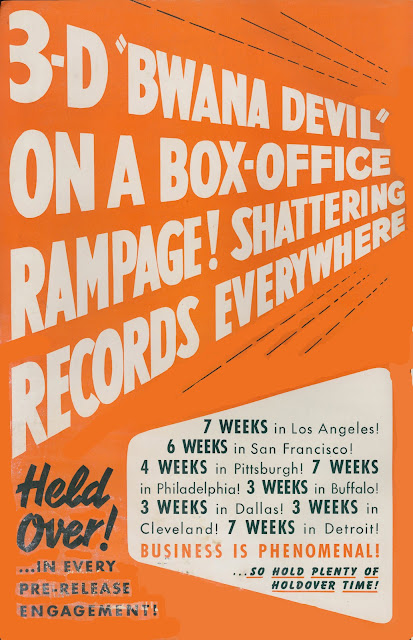Part Two From The Third Dimension
People attended initial 3-D shows like they’d go to see exotic species of animal on display. It was a novelty that lured out sober citizens who’d not otherwise dream of patronizing a film called Bwana Devil. The bigger elephant in corners (or rather, booths) of each theatre was odds against smooth presentation. Single projectionists were all of a sudden performing a two-man job. Every 3-D print coming through the door was twins, and both had to play in to-the-frame perfect synchronization. Catch one sprocket in your mechanism and suddenly there are a thousand malcontents removing their cardboard glasses to glare back at you. Defusing land mines was safer work in 1953.
Audiences had a right to expect an orderly program, especially with tickets selling at advanced prices for Natural Vision shows. 3-D jumping the track was not something you could fix with a lick and a promise. These were no five-minute waits for management to re-thread. A left or right side breakdown sent the whole bag ker-flooey, and fixing that needed cooler heads than most houses could summon. More than one audience spent their bits for half a show, if that. Still, it was something like nothing they’d seen before, and social capital could be acquired by youngsters especially who longed to experience 3-D and brag about it to their friends. A harried industry could only address snafus as they occurred, all the time knowing that if these didn’t somehow abate, their dream of a boxoffice redeemer-in-depth would soon be a lost one.
Three-Dimension became a catch-all term for any process that expanded our screen vision. Cinerama was getting its legs as Natural-Vision emerged and backers announced three-panel's expansion to twenty-five theatres for 1953. Projectionist unions struck in
Massive coinage at theatres hosting Arch Oboler’s freak hit was balm to disarray 3-D wrought upon house procedure. The Chicago Theatre took a smash $44,000 in its first three days of Bwana Devil, even with Sol Lesser’s competing Tri-Opticon show continuing to play next door at the Tele-News. It was the perfect backdrop against which Oboler fielded bids from major studios to take over distribution of Bwana Devil. By January’s third week, there was a dead heat between United Artists and producer Edward L. Alperson for those marbles.
A now re-titled Here Is Tri-Opticon widened in the meantime to
 |
| John Arnold, Chief of MGM's Camera Department, Shows Off The Dual Camera He's Built To Shoot Arena in 3-D |
 |
| Broadway's Loew's State Sees It's Single Week Record Broken by Bwana Devil. They had to Stop Selling Tickets Four Times on the Pic's First Weekend. |
UA’s sales force immediately went to work securing dates while interest was peaking. An immediate concern for the new distributor was shortage of prints and viewing glasses. UA had taken charge of 230 prior bookings in 225 cities and was reporting an avalanche of inquiry about playdates. Exhibitors wanted 3-D yesterday. There was no precedent for such anxiety to put a new attraction on screens. What UA lacked were personnel with knowledge and expertise about the exotic process they were now handling.
Arch Oboler had long been a proponent of 3-D and something of a visionary in his pursuit of feature-length depth photography. He had made a remarkable success of distributing Bwana Devil independently and securing dates in numerous first-run theatres. Oboler was tight with makers of Stereo-Realist slides and viewers, many of whom participated with tie-ins and window displays. His specially designed 3-D preview boxes attracted much attention in lobbies and out on sidewalks, while three million or so members of a thriving Stereo-Realist hobby group knew Oboler as a friend among their number and respected him. The independent producer even arranged for retailers to carry a special set of forty 3-D slides from Bwana Devil that collectors could enjoy on their own stereo viewers. Much of this hands-on enthusiasm that Oboler brought to his campaigning would dissipate once Bwana Devil was sold to United Artists.
Part Three and Conclusion on 3-D Next Week.









